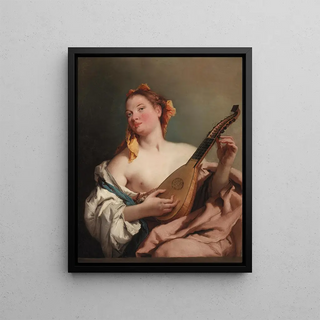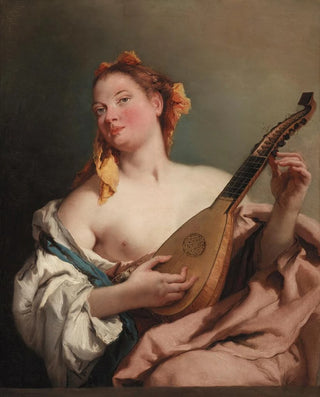Art print | Woman with a Mandolin - Giovanni Battista Tiepolo


View from behind

Frame (optional)
Femme à la mandoline - Giovanni Battista Tiepolo – Captivating Introduction
In the world of Baroque art, certain works transcend time and space, captivating the eye and mind of art enthusiasts across centuries. "Femme à la mandoline" by Giovanni Battista Tiepolo is undoubtedly one of those creations that, through its brilliance and depth, invites us to a visual and emotional exploration. This piece, imbued with delicacy and sophistication, immerses us in the intimacy of a scene where music and feminine beauty intertwine harmoniously. The depiction of a woman playing the mandoline evokes not only musical virtuosity but also a certain lightness of being—a suspended moment in time that resonates with the artist's soul.
Style and uniqueness of the work
Tiepolo's style is characterized by a masterful use of light and color, creating vibrant and enchanting atmospheres. In "Femme à la mandoline," the soft color palette and delicate nuances of the protagonist's clothing reflect meticulous attention to detail. The texture of the fabrics, the fluidity of movements, and the serene expression on the musician's face are all elements contributing to the magic of this art print. Tiepolo manages to capture not only the physical appearance of his subject but also the very essence of music, suggesting a silent dialogue between visual art and sound art. The composition, with its perfect balance between the main subject and the background, creates harmony that invites the viewer to immerse themselves in this peaceful universe.
The artist and his influence
Giovanni Battista Tiepolo, born in 1696 in Venice, is one of the undisputed masters of Rococo. His career, rich in achievements, is marked by numerous frescoes, portraits, and mythological scenes that testify to his creative genius. Influenced by the great masters of the Renaissance, Tiepolo developed a unique style that combines grandeur and lightness. His impact on European art is undeniable, inspiring many artists across the centuries. Tiepolo's ability to evoke deep emotions

Matte finish

View from behind

Frame (optional)
Femme à la mandoline - Giovanni Battista Tiepolo – Captivating Introduction
In the world of Baroque art, certain works transcend time and space, captivating the eye and mind of art enthusiasts across centuries. "Femme à la mandoline" by Giovanni Battista Tiepolo is undoubtedly one of those creations that, through its brilliance and depth, invites us to a visual and emotional exploration. This piece, imbued with delicacy and sophistication, immerses us in the intimacy of a scene where music and feminine beauty intertwine harmoniously. The depiction of a woman playing the mandoline evokes not only musical virtuosity but also a certain lightness of being—a suspended moment in time that resonates with the artist's soul.
Style and uniqueness of the work
Tiepolo's style is characterized by a masterful use of light and color, creating vibrant and enchanting atmospheres. In "Femme à la mandoline," the soft color palette and delicate nuances of the protagonist's clothing reflect meticulous attention to detail. The texture of the fabrics, the fluidity of movements, and the serene expression on the musician's face are all elements contributing to the magic of this art print. Tiepolo manages to capture not only the physical appearance of his subject but also the very essence of music, suggesting a silent dialogue between visual art and sound art. The composition, with its perfect balance between the main subject and the background, creates harmony that invites the viewer to immerse themselves in this peaceful universe.
The artist and his influence
Giovanni Battista Tiepolo, born in 1696 in Venice, is one of the undisputed masters of Rococo. His career, rich in achievements, is marked by numerous frescoes, portraits, and mythological scenes that testify to his creative genius. Influenced by the great masters of the Renaissance, Tiepolo developed a unique style that combines grandeur and lightness. His impact on European art is undeniable, inspiring many artists across the centuries. Tiepolo's ability to evoke deep emotions






